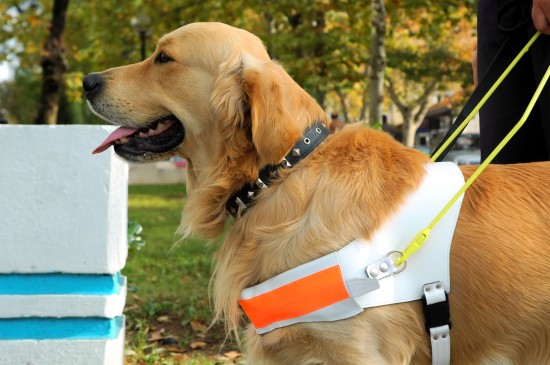

Guide dogs, seeing eye dogs and assistance dogs are just some of the terms used to refer to specially trained, highly intelligent dogs that help blind people and partially sighted people to navigate the world around them, and lead independent lives.
Everybody knows that the training, intelligence and skill level of guide dogs is highly complex, and far superior to that which most domestically kept dogs can ever achieve, with the training of potential guide dog puppies beginning when the dogs are just a few weeks old. However, few people really fully understand the whole remit of what is involved in training a guide dog, or just how wholly impressive the range of skills that they have is, and the things that they are capable of doing.
There are many different facets to life with a guide dog, and many elements of it don’t even occur to most people. But one common question people often ask, or consider about guide dogs handled by a blind or partially sighted person is “how does someone who cannot see know when their dog has done their business, and clean up after them?” The answer to this question is surprisingly complex, and very interesting!
Read on to learn more.
First of all, it is important to bear in mind that while some people who own a guide dog are completely blind with no vision at all, many more of them are partially sighted, and have some level of vision. This means that not everyone that owns or handles a guide dog will be unable to see when their dog goes to the toilet, and many guide dog owners will be alerted to their dog doing its business in the usual manner.
However, when you bear in mind how hard it can be for a person with perfect vision to know every time when their dog does their business and find it effectively, you can easily see the challenge faced by people with partial vision when it comes to cleaning up after their dogs.
Regardless of whether or not the dog’s handler has any vision at all, it is important to remember that guide dogs are professional, working animals, which have been taught and trained from an early age to make life easier for their handler. As such, what can be expected from a guide dog is generally much more than what you could expect from another dog.
Guide dogs help their owners to navigate through some very complicated situations, and every aspect of their lives is tasked with assisting their handler, and this extends to every element of their lives, including how and when they do their business!
As part of the training of guide dogs from the time when they are very small puppies, they are even toilet trained differently to other dogs. While they are taught the normal methods of asking to go out to the toilet and to hold it in until the right opportunity presents itself, their potty training does not stop there!
Guide dog puppies are taught verbal commands for a whole wide range of things, and one of these is actually associated with telling them when it is ok to do their business! Unless they are really desperate and have not been given the opportunity to go to the toilet for a prolonged period of time, guide dogs will as a general rule only go to the toilet on command where pooping is concerned!
Guide dog owners will work into their daily routine appropriate toilet breaks for their dogs, bearing in mind the times that the dog is fed, and the natural routine that the dog displays in terms of their need to do their business. When the time is right, the owner of the dog will instruct the dog to get busy doing their business with a verbal command-this can vary from dog to dog, with common commands including “do your business” or “potty time.”
Once the dog has got this training down to pat, the handler of the dog can literally give the dog the command, wait a short while for the dog to find a comfortable spot to go about it, and then wait for them to get on with it!
The dogs are also trained to permit and accept someone touching them while they go about their business, something that most dogs will not tolerate.
The stance that a dog takes on when going to the toilet varies, depending on whether they need to urinate or defecate. This can be judged by touch, by running a hand along the dog’s back. When squatting to pee, the back of the dog is flat, but when squatting to poop, the back will be slightly hunched. This lets the handler know whether or not they will be needing a pooh bag, and which direction the dog is facing to make their deposit!
Male guide dogs are also specially trained to squat to pee rather than cocking their legs, in order to allow their handlers to tell by touch if the dog is going to the toilet, and what they are doing. Then, once the dog has done their business and got up, the handler, despite their blindness or poor vision, can simply pick up the poop in their bag just like any other dog owner.
Clever!
Copyright © 2005-2016 Pet Information All Rights Reserved
Contact us: www162date@outlook.com